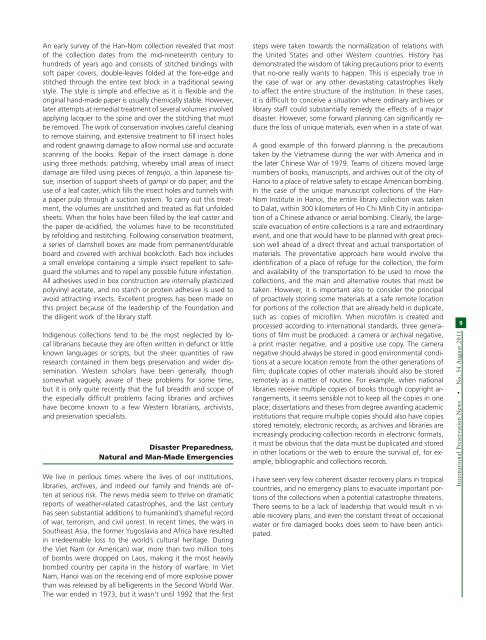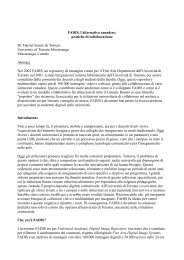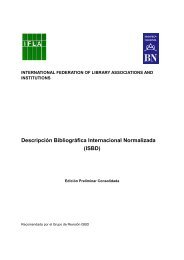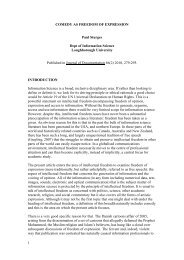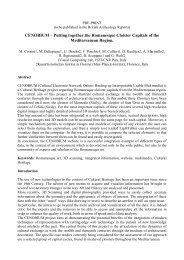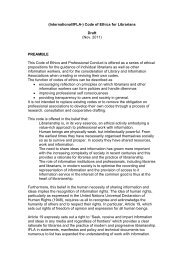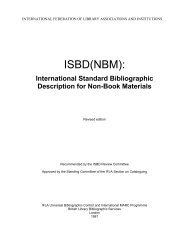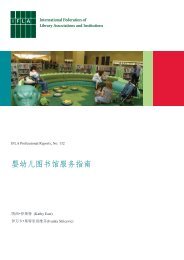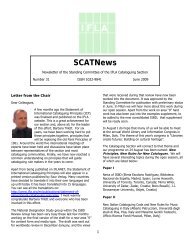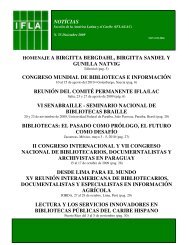N o 54 - IFLA
N o 54 - IFLA
N o 54 - IFLA
Create successful ePaper yourself
Turn your PDF publications into a flip-book with our unique Google optimized e-Paper software.
An early survey of the Han-Nom collection revealed that most<br />
of the collection dates from the mid-nineteenth century to<br />
hundreds of years ago and consists of stitched bindings with<br />
soft paper covers, double-leaves folded at the fore-edge and<br />
stitched through the entire text block in a traditional sewing<br />
style. The style is simple and effective as it is flexible and the<br />
original hand-made paper is usually chemically stable. However,<br />
later attempts at remedial treatment of several volumes involved<br />
applying lacquer to the spine and over the stitching that must<br />
be removed. The work of conservation involves careful cleaning<br />
to remove staining, and extensive treatment to fill insect holes<br />
and rodent gnawing damage to allow normal use and accurate<br />
scanning of the books. Repair of the insect damage is done<br />
using three methods: patching, whereby small areas of insect<br />
damage are filled using pieces of tengujo, a thin Japanese tissue;<br />
insertion of support sheets of gampi or do paper; and the<br />
use of a leaf caster, which fills the insect holes and tunnels with<br />
a paper pulp through a suction system. To carry out this treatment,<br />
the volumes are unstitched and treated as flat unfolded<br />
sheets. When the holes have been filled by the leaf caster and<br />
the paper de-acidified, the volumes have to be reconstituted<br />
by refolding and restitching. Following conservation treatment,<br />
a series of clamshell boxes are made from permanent/durable<br />
board and covered with archival bookcloth. Each box includes<br />
a small envelope containing a simple insect repellent to safeguard<br />
the volumes and to repel any possible future infestation.<br />
All adhesives used in box construction are internally plasticized<br />
polyvinyl acetate, and no starch or protein adhesive is used to<br />
avoid attracting insects. Excellent progress has been made on<br />
this project because of the leadership of the Foundation and<br />
the diligent work of the library staff.<br />
Indigenous collections tend to be the most neglected by local<br />
librarians because they are often written in defunct or little<br />
known languages or scripts, but the sheer quantities of raw<br />
research contained in them begs preservation and wider dissemination.<br />
Western scholars have been generally, though<br />
somewhat vaguely, aware of these problems for some time,<br />
but it is only quite recently that the full breadth and scope of<br />
the especially difficult problems facing libraries and archives<br />
have become known to a few Western librarians, archivists,<br />
and preservation specialists.<br />
Disaster Preparedness,<br />
Natural and Man-Made Emergencies<br />
We live in perilous times where the lives of our institutions,<br />
libraries, archives, and indeed our family and friends are often<br />
at serious risk. The news media seem to thrive on dramatic<br />
reports of weather-related catastrophes, and the last century<br />
has seen substantial additions to humankind’s shameful record<br />
of war, terrorism, and civil unrest. In recent times, the wars in<br />
Southeast Asia, the former Yugoslavia and Africa have resulted<br />
in irredeemable loss to the world’s cultural heritage. During<br />
the Viet Nam (or American) war, more than two million tons<br />
of bombs were dropped on Laos, making it the most heavily<br />
bombed country per capita in the history of warfare. In Viet<br />
Nam, Hanoi was on the receiving end of more explosive power<br />
than was released by all belligerents in the Second World War.<br />
The war ended in 1973, but it wasn’t until 1992 that the first<br />
steps were taken towards the normalization of relations with<br />
the United States and other Western countries. History has<br />
demonstrated the wisdom of taking precautions prior to events<br />
that no-one really wants to happen. This is especially true in<br />
the case of war or any other devastating catastrophes likely<br />
to affect the entire structure of the institution. In these cases,<br />
it is difficult to conceive a situation where ordinary archives or<br />
library staff could substantially remedy the effects of a major<br />
disaster. However, some forward planning can significantly reduce<br />
the loss of unique materials, even when in a state of war.<br />
A good example of this forward planning is the precautions<br />
taken by the Vietnamese during the war with America and in<br />
the later Chinese War of 1979. Teams of citizens moved large<br />
numbers of books, manuscripts, and archives out of the city of<br />
Hanoi to a place of relative safety to escape American bombing.<br />
In the case of the unique manuscript collections of the Han-<br />
Nom Institute in Hanoi, the entire library collection was taken<br />
to Dalat, within 300 kilometers of Ho Chi Minh City in anticipation<br />
of a Chinese advance or aerial bombing. Clearly, the largescale<br />
evacuation of entire collections is a rare and extraordinary<br />
event, and one that would have to be planned with great precision<br />
well ahead of a direct threat and actual transportation of<br />
materials. The preventative approach here would involve the<br />
identification of a place of refuge for the collection, the form<br />
and availability of the transportation to be used to move the<br />
collections, and the main and alternative routes that must be<br />
taken. However, it is important also to consider the principal<br />
of proactively storing some materials at a safe remote location<br />
for portions of the collection that are already held in duplicate,<br />
such as: copies of microfilm. When microfilm is created and<br />
processed according to international standards, three generations<br />
of film must be produced: a camera or archival negative,<br />
a print master negative, and a positive use copy. The camera<br />
negative should always be stored in good environmental conditions<br />
at a secure location remote from the other generations of<br />
film; duplicate copies of other materials should also be stored<br />
remotely as a matter of routine. For example, when national<br />
libraries receive multiple copies of books through copyright arrangements,<br />
it seems sensible not to keep all the copies in one<br />
place; dissertations and theses from degree awarding academic<br />
institutions that require multiple copies should also have copies<br />
stored remotely; electronic records, as archives and libraries are<br />
increasingly producing collection records in electronic formats,<br />
it must be obvious that the data must be duplicated and stored<br />
in other locations or the web to ensure the survival of, for example,<br />
bibliographic and collections records.<br />
I have seen very few coherent disaster recovery plans in tropical<br />
countries, and no emergency plans to evacuate important portions<br />
of the collections when a potential catastrophe threatens.<br />
There seems to be a lack of leadership that would result in viable<br />
recovery plans, and even the constant threat of occasional<br />
water or fire damaged books does seem to have been anticipated.<br />
9<br />
International Preservation News • No. <strong>54</strong> August 2011


